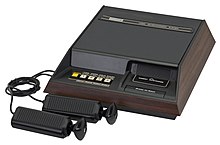General Discussion
Related: Editorials & Other Articles, Issue Forums, Alliance Forums, Region ForumsBlack History, day 4: Jerry Lawson (engineer)
Jerry Lawson (engineer)
 ?quality=99&strip=all&w=660
?quality=99&strip=all&w=660
https://en.wikipedia.org/wiki/Jerry_Lawson_(engineer)
Gerald Anderson "Jerry" Lawson (December 1, 1940 – April 9, 2011)[1][2] was an American electronic engineer, and one of the few African-American engineers in the industry at that time. He is known for his work in designing the Fairchild Channel F video game console as well as inventing the video game cartridge.[3]
Early life
Lawson was born in Brooklyn, New York City on December 1, 1940.[4] His father Blanton was a longshoreman with an interest in science, while his mother Mannings worked for the city, and also served on the PTA for the local school and made sure that he received a good education.[5] Both encouraged his interests in scientific hobbies, including ham radio and chemistry. Lawson said that his first-grade teacher helped him encourage his path to be someone influential similar to George Washington Carver.[4] While in high school, he earned money by repairing television sets. He attended both Queens College and City College of New York, but did not complete a degree at either.[4]
Career

The Fairchild Channel F, with the cartridge slot on the right of the unit
In 1970, he joined Fairchild Semiconductor in San Francisco as an applications engineering consultant within their sales division. While there, he created the early arcade game Demolition Derby out of his garage.[4][5] In the mid-1970s, Lawson was made Chief Hardware Engineer[6] and director of engineering and marketing for Fairchild's video game division.[4] There, he led the development of the Fairchild Channel F console, released in 1976 and specifically designed to use swappable game cartridges. At the time, most game systems had the game programming stored on ROM storage soldered onto the game hardware, which could not be removed. Lawson and his team figured out how to move the ROM to a cartridge that could be inserted and removed from a console unit repeatedly, and without electrically shocking the user. This would allow users to buy into a library of games, and provided a new revenue stream for the console manufacturers through sales of these games.[7] Lawson's invention of the interchangeable cartridge was so novel that every cartridge he produced had to be approved by the Federal Communications Commission.[8] The Channel F was not a commercially successful product, but the cartridge approach was picked up by other console manufacturers, popularized with the Atari 2600 released in 1977.[9][10]
While he was with Fairchild, Lawson and Ron Jones were the sole black members of the Homebrew Computer Club, a group of early computer hobbyists which would produce a number of industry legends, including Apple founders Steve Jobs and Steve Wozniak.[9] Lawson had noted he had interviewed Wozniak for a position at Fairchild, but did not hire him.[4]
In 1980, Lawson left Fairchild and founded Videosoft, a video game development company which made software for the Atari 2600 in the early 1980s, as the 2600 had displaced the Channel F as the top system in the market.[3][11] Videosoft closed about five years later, and Lawson started to take on consulting work. At one point, he had been working with Stevie Wonder to produce a "Wonder Clock" that would wake a child with the sound of a parent's voice, though it never made it to production.[7] Lawson later worked with the Stanford mentor program and was preparing to write a book on his career.[9]
In March 2011, Lawson was honored as an industry pioneer for his work on the game cartridge concept by the International Game Developers Association (IGDA).[7]
Death
Around 2003, Lawson started having complications from diabetes, losing the use of one leg and sight from one eye.[5] On April 9, 2011, about one month after being honored by the IGDA, he died of complications from diabetes.[4][7] At the time of his death, he resided in Santa Clara, California, and was survived by his wife, two children, and his brother.[4]